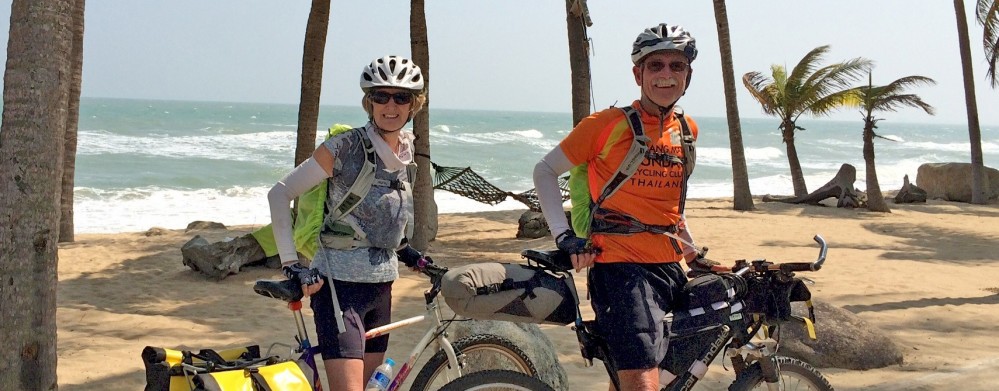 Yet another bicycle parade and this one was flanked by vintage motorcycles, restored volkswagens and the town’s Tuk-tuks. Most of southern Thailand’s economy is founded on harvesting rubber from it’s rubber tree plantations, not to mention rice and palm oil, but rubber trees grow best in this region of Thailand primarily due to it’s latitude and associated climate. There doesn’t appear to be Agri-Business managing and producing all these tens of thousands of hectares of patch-work, mostly small family-owned groves of trees planted on old flat rice fields as well as on the hilly inclines.
Yet another bicycle parade and this one was flanked by vintage motorcycles, restored volkswagens and the town’s Tuk-tuks. Most of southern Thailand’s economy is founded on harvesting rubber from it’s rubber tree plantations, not to mention rice and palm oil, but rubber trees grow best in this region of Thailand primarily due to it’s latitude and associated climate. There doesn’t appear to be Agri-Business managing and producing all these tens of thousands of hectares of patch-work, mostly small family-owned groves of trees planted on old flat rice fields as well as on the hilly inclines.
 In 1899 a provincial governor who had travelled “abroad” brought the first rubber trees back to stimulate Thai agriculture, and planted them just down the road from Trang in Kantang. This parade and celebration was for Rubber Tree Day and constituted the biggest parade we’ve seen, or been a part of, since visiting Thailand. All the various parading constituents met at different locales around town and coalesced at Trang’s largest stadium fairgrounds, where gigantic gymnasium-sized tents covered agricultural displays, food stands and fair attractions.
In 1899 a provincial governor who had travelled “abroad” brought the first rubber trees back to stimulate Thai agriculture, and planted them just down the road from Trang in Kantang. This parade and celebration was for Rubber Tree Day and constituted the biggest parade we’ve seen, or been a part of, since visiting Thailand. All the various parading constituents met at different locales around town and coalesced at Trang’s largest stadium fairgrounds, where gigantic gymnasium-sized tents covered agricultural displays, food stands and fair attractions.
One massive display on the fairgrounds we only saw the end of, as we cycled in thru the center of the grounds, was an elephant pulling a giant stone roller that was used to build the roads over the mountain passed between the peninsula’s coastal regions. Sorry no photos, as the elephant was discharged while all 250 bicycles were herded to the forefront of a concert stage. SunSern explained that before the use of dynamite they would “fire” (heat) the boulders in the way of a roadbed and then pour water on them to crack the rock. Then the labors would “cut and fill” and the elephants would “roll” these Flintstone-sized rollers (almost the size of those VW bugs in the parade) to smooth out the roadbed.
 Besides the transport-mode participants in the parade, there were quite a number of flatbed truck-mounted floats depicting the various stages of Rubber Tree development including taping the rubber water and pressing the liquid into the door-mat-sized product we see drying adjacent the plantation’s family mangle-looking presses throughout this region. Now-a-days, the rubber water is more often collected daily from plastic 20-liter containers into 50-gallon drums and then later in the day pumped into pick-up-mounted 300 gallon tanks and finally taken to a wholesaler who fills a 20-wheeled tanker truck. Mat production only occurs in areas where access to daily trucking is limited, like the islands and deep in the hill country.
Besides the transport-mode participants in the parade, there were quite a number of flatbed truck-mounted floats depicting the various stages of Rubber Tree development including taping the rubber water and pressing the liquid into the door-mat-sized product we see drying adjacent the plantation’s family mangle-looking presses throughout this region. Now-a-days, the rubber water is more often collected daily from plastic 20-liter containers into 50-gallon drums and then later in the day pumped into pick-up-mounted 300 gallon tanks and finally taken to a wholesaler who fills a 20-wheeled tanker truck. Mat production only occurs in areas where access to daily trucking is limited, like the islands and deep in the hill country.
Mat rubber is used for the heavy rubber production of items like tires, whereas the liquid rubber can be used to form “finer” items like gloves and gaskets. Thailand ranks 1st in world natural rubber production, however synthetic rubber production has outgrown the demand for natural rubber. Between synthetic rubber and competition in neighboring countries the price of rubber has just recently dropped from 180 Baht a kilo to 30 Baht.
 This was the second time in three days that we were filmed by a drone-mounted GoPro. I guess this is the norm for ariel photography and works well with parades and large gatherings.
This was the second time in three days that we were filmed by a drone-mounted GoPro. I guess this is the norm for ariel photography and works well with parades and large gatherings.
 We didn’t stay for the food fair provided to the participants. SunSern and his wife took us to a favorite Thail restaurant where we gorged on delicious dishes, some familiar and other new, like the pounded catfish that explodes into a light puffy bird’s nest of taste when poured into a wok of palm oil. It’s topped at the table with grated mango in fish sauce. A Roi.
We didn’t stay for the food fair provided to the participants. SunSern and his wife took us to a favorite Thail restaurant where we gorged on delicious dishes, some familiar and other new, like the pounded catfish that explodes into a light puffy bird’s nest of taste when poured into a wok of palm oil. It’s topped at the table with grated mango in fish sauce. A Roi.





